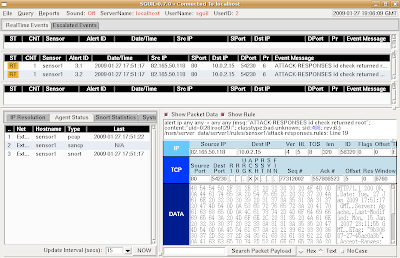Step 1: Add a new function to your snort.lua file
If you followed my previous SnortSP Installation HOWTO, then the default snort.lua file is in /etc/SnortSP/snort.lua. Open the file and add the following function:
function bridge(interface1, interface2)
if interface1 == nil then
error("Two interfaces must be specified ( e.g. bridge(\"eth0\", \"eth1\") )")
end
if interface2 == nil then
error("Two interfaces must be specified ( e.g. bridge(\"eth0\", \"eth1\") )")
end
dsrc2 = {name="src2",
type="afpacket",
intf=interface1..":"..interface2,
flags=10,
snaplen=1518,
maxflows=262144,
maxidle=300,
flow_memcap=10000000}
dsrc.new(dsrc2)
eng.new("e2")
eng.link({engine="e2", source="src2"})
eng.start("e2")
end
Step 2: Start SnortSP
Start SnortSP using the following command:
sudo snortsp -L /etc/SnortSP/snort.luaSnortSP will start up and read your new snort.lua file. You will then be greeted by the SnortSP Lua shell.
Step 3: Use the bridge() function
In the Lua shell, type the following (replacing eth0 and eth1 with the correct interfaces on your system):
bridge("eth0", "eth1")
Once the bridge is up and running, you can do the following to display packets traversing the bridge:
eng.set_display({engine="e2", display="none"})
Press the Up arrow and change "none" to "classic".
View the output.
Press the Up arrow twice to retrieve the "none" command and press Enter.
When finished, shut down SnortSP by running the following command:
ssp.shutdown()
Note that there is a bug in the SnortSP README file (and/or the SnortSP afpacket DAQ itself). The README file suggests the following:
dsrc1 = {name="src",
type="afpacket",
intf="eth2:eth3",
flags=10,
snaplen=0,
maxflows=262144,
maxidle=300,
flow_memcap=10000000}
dsrc.new(dsrc1)



